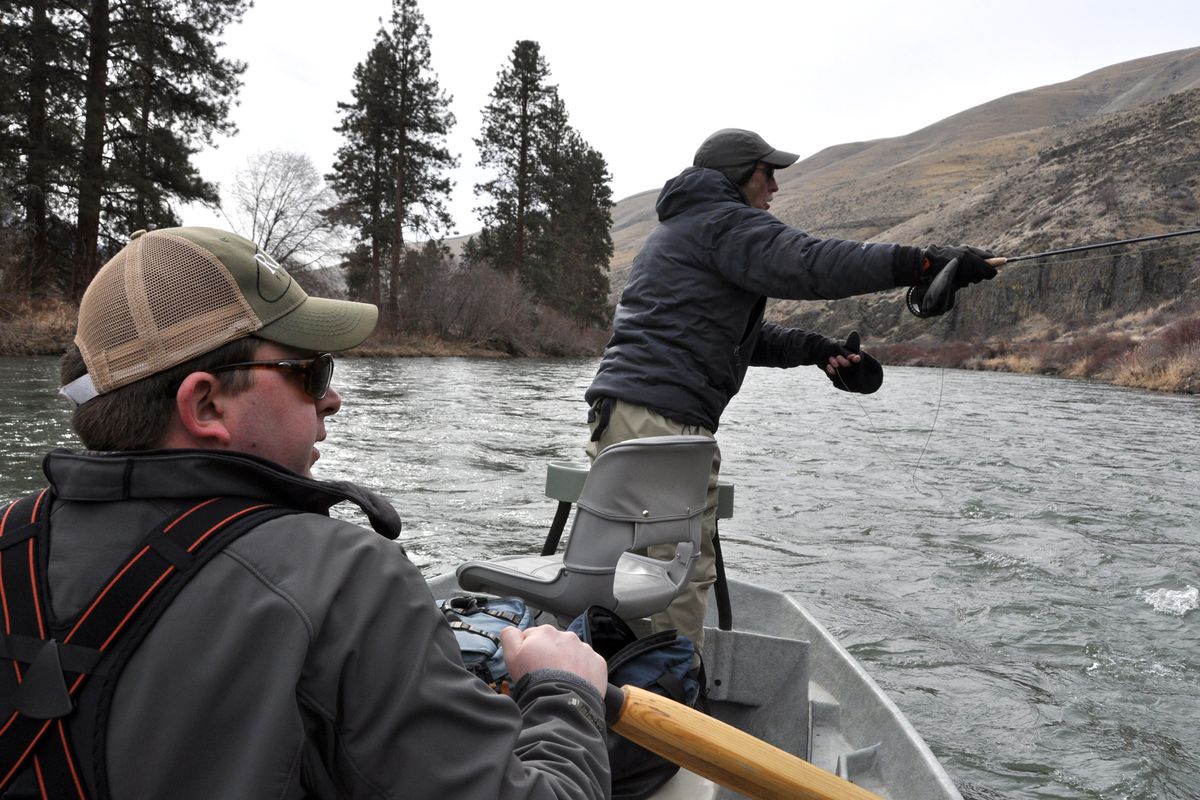Skwala stonefly hatch coming soon, but why wait?

The meat show on the region’s trout streams is still a few weeks away, but that didn’t stop us from showing up early for the party.
We knew the reception would be chilly at the Yakima River.
The skwala stonefly nymphs would prefer staying among the rocks in the frigid 35-degree water to crawling out on a limb – where the air temperature was below freezing.
Ice chunks lined the shore 3 feet above the river, indicating the crest of last week’s high flows.
The water had cleared to about 14 inches of visibility.
I named and became intimate friends with all of the few midges I saw hopping across the water over five hours.
Otherwise, it was a pretty good day to go fishing and survey the Yakima for early risers.
Floating a river offers much higher odds of catching a fish than sitting in an office, regardless of the season. And Yakima River fly-fishing guides were offering big discounts to entice anglers into their drift boats.
Their websites threw out the bait. “Skwala’s coming soon … Another few degrees warmer and game is on. …”
Skwala stoneflies are a slightly smaller version of the fabled salmonflies; different but similar. The skwala’s get it on earlier than salmonflies as the nymphs migrate along rocky stream bottoms to the shoreline in March before crawling out on grass and brush, emerging as adults to mate, deposit eggs in the river and cause fish to rise and anglers to drive long distances.
The guides were careful not to promise the first skwala stoneflies of the season would be flying and enticing rainbows to the surface on Tuesday.
We expected the possibility of slow fishing, and it was, at first.
Mike Kennedy of Red’s Fly Shop recommended starting with beadhead Hair’s Ear Nymph variations dangling under big foam-body skwala dry patterns.
Drifting a dry fly the size of a small bird at the end of February is a bit optimistic. A sign of hope. An indicator of a willingness to be lucky.
I had left Spokane at 6:30 a.m. with multiple articles of fleece clothing to layer under my fishing waders and windproof jacket. My wife had kissed me goodbye with that look of pity she reserves for people too dumb to avoid misery.
But once we launched into the canyon stretch of the Yakima downstream from Ellensburg, the game WAS on, even if the bite was not.
David Moershel and I made cast after cast, with Kennedy regularly dipping into his fly boxes for different fly-pattern combinations for us to try: big-small, small-small, big-big. We tried single files with indicators and without. We stripped in Sculpzillas and other streamers. We cast various dries, and even threw a Tantrum.
Nothing. A few missed takes, maybe, but nothing to verify that trout hadn’t been extirpated from the Yakima since we last fished there.
The highlight of the morning was hot soup at noon. I wanted to dip my numb fingers into the steaming bowl as much as I wanted to put the heat in my core.
A storm was moving in and the afternoon was even colder. River water from our fly lines would freeze in the rod guides as we cast, but we’re glad we never stopped fishing.
About 1 p.m., as if to lift us from the verge of despair, a trout rose.
“What the … Did you see that?” Moershel said.
We couldn’t detect a thing on the water that would make a fish rise.
“Must have been curious,” I said.
We tried some dries to no avail and went back to basics with a pre-skwala-hatch nymph pattern we’d used unsuccessfully in the morning: a Pat’s Rubber Legs under an indicator.
The skwala nymphs weren’t necessarily bunching up along the shoreline yet, and Kennedy reminded us to fish away from the bank, sometimes well out in the river, along foam lines and seams where water color changed.
Wham!
My first rainbow hit the nymph 20 feet from shore under foam in the slower water of a submerged boulder field.
The fish torpedoed toward the boat, forcing me to raise the 9-foot rod high above my head and rip in line as though I were a conductor bringing the symphony to a crescendo and the audience to a standing ovation.
Despite the cold, the trout broke water twice, making me wonder how spectacular he would be to catch when the water was warm enough to get its metabolism in high gear.
Soon Moershel had a huge whitefish that peeled off line.
Minutes later, he was reeling in a nice rainbow. My fishing buddy was reminding the fish that its winter respite was over and that a bunch of anglers would be invading the river from Western Washington in a few weeks.
Then my indicator went down as the Rubber Legs duped yet another chunky rainbow.
We called it quits by 3:30 p.m. after an hour with warm memories of a fishing trip that made us forget it was winter.
We saw only one other boat on our stretch of the Yakima River Tuesday.
Kennedy knew them and waved.
“Three guides fishing together on a day off,” he said.
“Guides don’t go fishing when there’s not a good chance to catch fish.”